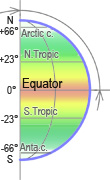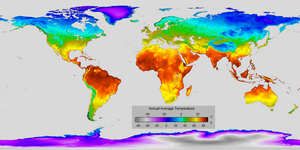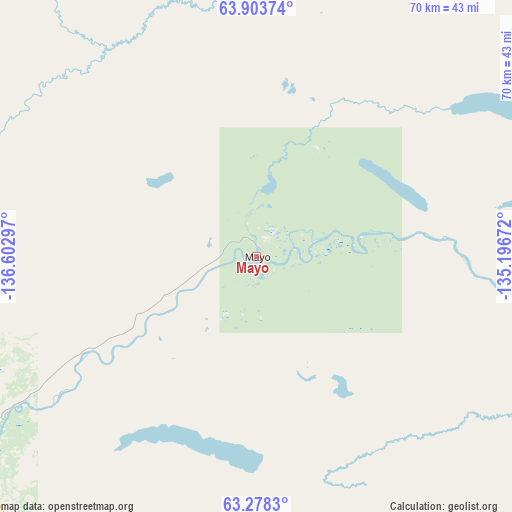Mayo geodata
Mayo (Yukon) is a populated place; located in Canada in America/Whitehorse (GMT-7) time zone. With population of 540 people, there are 1167 cities with bigger population in this country. Compared to other cities in Canada, 98.7% of cities are located further ↓South; 99.8% of cities are located further →East and 85.6% of cities have lower elevation than Mayo. Note1
Mayo GPS coordinates[2]
63° 35' 33.864" North, 135° 53' 59.424" West
| Map corner | latitude | longitude |
|---|---|---|
| Upper-left | 63.90374°, | -136.60297° |
| Center: | 63.59274°, | -135.89984° |
| Lower-right: | 63.2783°, | -135.19672° |
| Map W x H: | 69.5×69.5 km | = 43.2×43.2mi |
| max Lat: | 73.03752° ⇑1.3% North |
| Mayo: | 63.59274° |
| min Lat: | ⇓98.7% South 42.05009° |
| min Long | Mayo | max Long |
| -139.43328° | -135.89984° | -52.70931° |
| W 0.2%⇐ | ⇒99.8% E |
Elevation
Elevation of Mayo is 581 m = 1906 ft, and this is 326.6 m = 1072 ft above average elevation for this country.
| Max E: |
1518 m = 4980 ft | 14.4% |
| Mayo | 581 m 1906 ft | |
| Avg. | 254.4 m = 835 ft | |
Min E: |
-2 m = -7 ft | 85.6% |
See also: Canada elevation on elevation.city.
Geographical zone
Mayo is located in North temperate zone (between Tropic of Cancer and the Arctic Circle). Distance of this North polar circle is 330.3 km =205.2 mi to North.| Distance of | km | miles | from Mayo |
|---|---|---|---|
| North Pole | 2936.2 | 1824.5 | to North |
| Arctic Circle | 330.3 | 205.2 | to North |
| Tropic Cancer | 4464.9 | 2774.4 | to South |
| Equator | 7070.8 | 4393.6 | to South |



Nearby cities:
4 places around Mayo: (largest is in red/bold)
• Dawson City
180.9 km =112.4 mi,  286°
286°
• Fort McPherson
430.2 km =267.3 mi,  6°
6°
• Haines Junction
326.7 km =203 mi,  194°
194°
• Whitehorse
322.8 km =200.6 mi,  172°
172°
Sources, notices
• [Note1] Compared only with cities in Canada existing in our database
• [Src1] Map data: © OpenStreetMap contributors (CC-BY-SA)
• [Src2] Other city data from geonames.org with taken over terms of usage.
• [Src3] Geographical zone / Annual Mean Temperature by Robert A. Rohde @ Wikipedia



